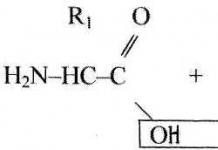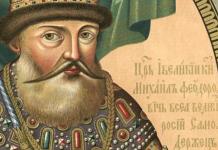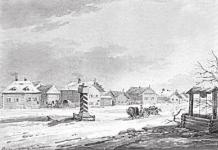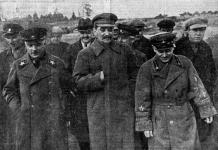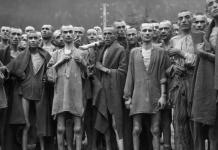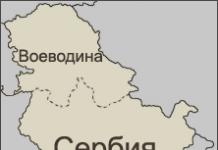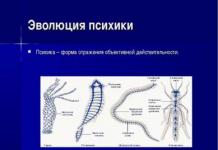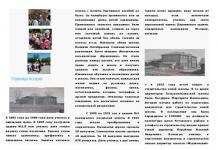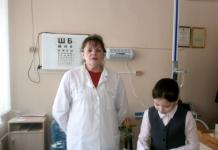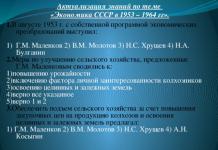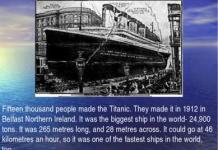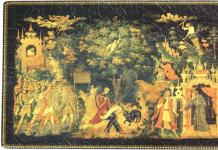chemical bond- these are the interactions of electrons and the atomic nucleus of one particle (atom, ion, molecule, etc.) with electrons and the atomic nucleus of another particle, holding these particles in a stable or metastable chemical compound. Modern description chemical bond carried out on the basis quantum mechanics. The main characteristics of a chemical bond are strength, length, polarity.
Communication types
- Single electron chemical bond
- metal connection
- covalent bond
- Ionic bond
- Van der Waals connection
- hydrogen bond
- Two-electron three-center chemical bond
The simplest one-electron covalent chemical bond
The simplest one-electron chemical bond is created by a single valence electron. It turns out that one electron is able to hold two positively charged ions in a single whole. In a one-electron bond, the Coulomb repulsive forces of positively charged particles are compensated by the Coulomb forces of attraction of these particles to a negatively charged electron. The valence electron becomes common to the two nuclei of the molecule.
Examples such chemical compounds are molecular ions: H 2+, Li 2+, Na 2+, K 2+, Rb 2+, Cs 2+
Single covalent bond

A single covalent chemical bond is created by a bonding electron pair. In all existing theories (the theory of valence bonds, the theory molecular orbitals, the theory of repulsion of valence electron pairs, the Bohr model of chemical bonding) the bonding electron pair is located in the space between the atoms of the molecule. Distinguish between polar and non-polar covalent bonds.
A nonpolar covalent bond takes place in homonuclear diatomic molecules in which the bonding electronI pair is equidistant from both nuclei of the molecular system.
Distance d between atomic nuclei can be viewed as the sum of the covalent radii of the corresponding atoms.
The distance between atomic nuclei in a single two-electron covalent bond is shorter than the same distance in the simplest one-electron chemical bond.
Multiple covalent bonds
Multiple covalent bonds are represented by unsaturated organic compounds containing double and triple chemical bonds. To describe the nature of unsaturated compounds, L. Pauling introduces the concepts of sigma- and π-bonds, hybridization of atomic orbitals.


Pauling's hybridization for two S- and two p-electrons made it possible to explain the directionality of chemical bonds, in particular, the tetrahedral configuration of methane. To explain the structure of ethylene, it is necessary to isolate one p-electron from four equivalent Sp3 electrons of the carbon atom to form an additional bond, called the π-bond. In this case, the three remaining Sp2 hybrid orbitals are located in the plane at an angle of 120° and form the main bonds, for example, a planar ethylene molecule.
In the case of the acetylene molecule, only one S and one p orbitals take part in hybridization (according to Pauling), and two Sp orbitals are formed, located at an angle of 180 ° and directed to opposite sides. Two "clean" p-orbitals of carbon atoms overlap in pairs in mutually perpendicular planes, forming two π-bonds of a linear acetylene molecule.
The views of L. Pauling were reflected in his book “The Nature of the Chemical Bond”, which for many years became the reference book of the chemist. In 1954, L. Pauling was awarded Nobel Prize in Chemistry with the wording "For the study of the nature of the chemical bond and its application to the determination of the structure of complex compounds."
However physical meaning selective hybridization of atomic orbitals remained unclear, hybridization represented algebraic transformations to which physical reality could not be attributed.
Linus Pauling made an attempt to improve the description of the chemical bond by eliminating the selectivity of hybridization of orbitals in the molecules of unsaturated compounds and creating the theory of a bent chemical bond. In his report at a symposium on theoretical organic chemistry, dedicated to the memory of Kekule (London, September 1958), L. Pauling proposed a new way to describe a double bond as a combination of two identical curved chemical bonds, and a triple bond - three curved chemical bonds. On this
Symposium L. Pauling categorically stated:
There may be chemists who think that an extremely important innovation ... was the description of the σ, π- description for double or triple bonds and conjugated systems instead of the description with bent bonds. I maintain that the σ,π description is less satisfactory than the curved link description, that this innovation is only transitory and will soon die out.
AT new theory Pauling, all binding electrons became equal and equidistant from the line connecting the nuclei of the molecule. Pauling's theory of a bent chemical bond took into account the statistical interpretation of the wave function by M. Born, the Coulomb electron correlation of electrons. A physical meaning appeared - the nature of the chemical bond is completely determined by the electrical interaction of nuclei and electrons. The more bonding electrons, the smaller the internuclear distance and the stronger the chemical bond between carbon atoms.
Three-center chemical bond
Further development of ideas about the chemical bond was given by the American physical chemist W. Lipscomb, who developed the theory of two-electron three-center bonds and a topological theory that makes it possible to predict the structure of some more boron hydrides (borohydrides). 
An electron pair in a three-center chemical bond becomes common to three atomic nuclei. In the simplest representative of a three-center chemical bond - the molecular hydrogen ion H3 +, an electron pair holds three protons in a single whole.
There are four single covalent bonds in the diborane molecule. B-H connections and two two-electron three-center bonds. The internuclear distance in a single covalent B-H bond is 1.19 Å, while the similar distance in a three-center B-H-B bond is 1.31 Å. The angle of the three-center bond B-H-B (φ) is 830. The combination of two three-center bonds in the diborane molecule makes it possible to keep the nuclei of boron atoms at a distance dB-B = 2 1.31 sin φ/2 = 1.736 Å. The nuclei of the binding hydrogen atoms are located at a distance h = 1.31 · cos φ/2 = 0.981 Å from the plane in which four single B-H covalent bonds are located.
Three-center bonds can be realized not only in a triangle of two boron atoms and one hydrogen atom, but also between three boron atoms, for example, in framework borohydrides (pentaborane - B 5 H 9, decaborane - B 10 H 4, etc.). These structures contain ordinary (terminal) and three-center bond (bridge) hydrogen atoms and triangles of boron atoms.
The existence of boranes with their two-electron three-center bonds with "bridge" hydrogen atoms violated the canonical doctrine of valency. The hydrogen atom, previously considered a standard univalent element, turned out to be bound by identical bonds with two boron atoms and became formally a divalent element. The work of W. Lipscomb on deciphering the structure of boranes expanded the understanding of the chemical bond. The Nobel Committee awarded the William Nunn Lipscomb Prize in Chemistry in 1976 with the wording "For his investigations into the structure of boranes (borohydrites) which elucidate the problems of chemical bonds".
Multicenter chemical bond
In 1951, T. Keely and P. Pawson unexpectedly obtained a completely new organo-iron compound during the synthesis of dicyclopentadienyl. The preparation of a previously unknown, extremely stable yellow-orange crystalline iron compound immediately attracted attention.

E. Fisher and D. Wilkinson independently established the structure of the new compound - two cyclopentadienyl rings are arranged in parallel, in layers, or in the form of a “sandwich” with an iron atom located between them in the center (Fig. 8). The name "ferrocene" was proposed by R. Woodward (or rather, an employee of his group, D. Whiting). It reflects the presence in the compound of an iron atom and ten carbon atoms (zehn - ten).
All ten bonds (C-Fe) in the ferrocene molecule are equivalent, the Fe-c internuclear distance is 2.04 Å. All carbon atoms in a ferrocene molecule are structurally and chemically equivalent, the length of each C-C connections 1.40 - 1.41 Å (for comparison, in benzene the C-C bond length is 1.39 Å). A 36-electron shell appears around the iron atom.
In 1973, Ernst Otto Fischer and Jeffrey Wilkinson were awarded the Nobel Prize in Chemistry for their pioneering, independently done work in the field of organometallic, so-called sandwich compounds. Indvar Lindqvist, Fellow of the Royal Swedish Academy of Sciences, in his speech at the presentation of the laureates, stated that “the discovery and proof of new principles of bonds and structures found in sandwich compounds is a significant achievement, practical significance which are currently unpredictable.
At present, dicyclopentadienyl derivatives of many metals have been obtained. Derivatives transition metals have the same structure and the same bond nature as ferrocene. The lanthanides do not form a sandwich structure, but a structure resembling a three-beam star [The atoms of La, Ce, Pr, Nd, therefore, create a fifteen-center chemical bond.
Soon after ferrocene, dibenzenechromium was obtained. Dibenzene-molybdenum and dibenzene-vanadium were prepared according to the same scheme. In all compounds of this class, the metal atoms hold together two six-membered rings. All 12 metal-carbon bonds in these compounds are identical.

Uranocene [bis(cyclooctatetraene)uranium] has also been synthesized, in which the uranium atom holds two eight-membered rings. All 16 uranium-carbon bonds in the uranocene are identical. Uranocene is obtained by reacting UCl 4 with a mixture of cyclooctatetraene and potassium in tetrahydrofuran at minus 300 C.
Topics of the USE codifier: Covalent chemical bond, its varieties and mechanisms of formation. Characteristics of a covalent bond (polarity and bond energy). Ionic bond. Metal connection. hydrogen bond
Intramolecular chemical bonds
Let us first consider the bonds that arise between particles within molecules. Such connections are called intramolecular.
chemical bond
between atoms chemical elements has an electrostatic nature and is formed due to interactions of external (valence) electrons, in more or less degree held by positively charged nuclei bonded atoms.The key concept here is ELECTRONEGNATIVITY. It is she who determines the type of chemical bond between atoms and the properties of this bond.
is the ability of an atom to attract (hold) external(valence) electrons. Electronegativity is determined by the degree of attraction of external electrons to the nucleus and depends mainly on the radius of the atom and the charge of the nucleus.
Electronegativity is difficult to determine unambiguously. L. Pauling compiled a table of relative electronegativity (based on the bond energies of diatomic molecules). The most electronegative element is fluorine with meaning 4 .
It is important to note that in different sources you can find different scales and tables of electronegativity values. This should not be frightened, since the formation of a chemical bond plays a role atoms, and it is approximately the same in any system.
If one of the atoms in the chemical bond A:B attracts electrons more strongly, then the electron pair is shifted towards it. The more electronegativity difference atoms, the more the electron pair is displaced.
If the electronegativity values of the interacting atoms are equal or approximately equal: EO(A)≈EO(V), then the shared electron pair is not displaced to any of the atoms: A: B. Such a connection is called covalent non-polar.
If the electronegativity of the interacting atoms differ, but not much (the difference in electronegativity is approximately from 0.4 to 2: 0,4<ΔЭО<2 ), then the electron pair is shifted to one of the atoms. Such a connection is called covalent polar .
If the electronegativity of the interacting atoms differ significantly (the difference in electronegativity is greater than 2: ΔEO>2), then one of the electrons almost completely passes to another atom, with the formation ions. Such a connection is called ionic.
The main types of chemical bonds are − covalent, ionic and metallic connections. Let's consider them in more detail.
covalent chemical bond
covalent bond – it's a chemical bond formed by formation of a common electron pair A:B . In this case, two atoms overlap atomic orbitals. A covalent bond is formed by the interaction of atoms with a small difference in electronegativity (as a rule, between two non-metals) or atoms of one element.
Basic properties of covalent bonds
- orientation,
- saturability,
- polarity,
- polarizability.
These bond properties affect the chemical and physical properties of substances.
Direction of communication characterizes the chemical structure and form of substances. The angles between two bonds are called bond angles. For example, in a water molecule, the H-O-H bond angle is 104.45 o, so the water molecule is polar, and in the methane molecule, the H-C-H bond angle is 108 o 28 ′.
Saturability is the ability of atoms to form a limited number of covalent chemical bonds. The number of bonds that an atom can form is called.
Polarity bonds arise due to the uneven distribution of electron density between two atoms with different electronegativity. Covalent bonds are divided into polar and non-polar.
Polarizability connections are the ability of bond electrons to be displaced by an external electric field(in particular, the electric field of another particle). The polarizability depends on the electron mobility. The farther the electron is from the nucleus, the more mobile it is, and, accordingly, the molecule is more polarizable.
Covalent non-polar chemical bond
There are 2 types of covalent bonding - POLAR and NON-POLAR .
Example . Consider the structure of the hydrogen molecule H 2 . Each hydrogen atom carries 1 unpaired electron in its outer energy level. To display an atom, we use the Lewis structure - this is a diagram of the structure of the external energy level of an atom, when electrons are denoted by dots. Lewis point structure models are a good help when working with elements of the second period.
H. + . H=H:H
Thus, the hydrogen molecule has one common electron pair and one H–H chemical bond. This electron pair is not displaced to any of the hydrogen atoms, because the electronegativity of hydrogen atoms is the same. Such a connection is called covalent non-polar .
Covalent non-polar (symmetrical) bond - this is a covalent bond formed by atoms with equal electronegativity (as a rule, the same non-metals) and, therefore, with a uniform distribution of electron density between the nuclei of atoms.
The dipole moment of nonpolar bonds is 0.
Examples: H 2 (H-H), O 2 (O=O), S 8 .
Covalent polar chemical bond
covalent polar bond is a covalent bond that occurs between atoms with different electronegativity (usually, different non-metals) and is characterized displacement common electron pair to a more electronegative atom (polarization).
The electron density is shifted to a more electronegative atom - therefore, a partial negative charge (δ-) appears on it, and a partial positive charge appears on a less electronegative atom (δ+, delta +).
The greater the difference in the electronegativity of atoms, the higher polarity connections and even more dipole moment . Between neighboring molecules and charges opposite in sign, additional attractive forces act, which increases strength connections.
Bond polarity affects the physical and chemical properties of compounds. The reaction mechanisms and even the reactivity of neighboring bonds depend on the polarity of the bond. The polarity of a bond often determines polarity of the molecule and thus directly affects such physical properties as boiling point and melting point, solubility in polar solvents.
Examples: HCl, CO 2 , NH 3 .
Mechanisms for the formation of a covalent bond
A covalent chemical bond can occur by 2 mechanisms:
1. exchange mechanism the formation of a covalent chemical bond is when each particle provides one unpaired electron for the formation of a common electron pair:
AND . + . B= A:B
2. The formation of a covalent bond is such a mechanism in which one of the particles provides an unshared electron pair, and the other particle provides a vacant orbital for this electron pair:
AND: + B= A:B
In this case, one of the atoms provides an unshared electron pair ( donor), and the other atom provides a vacant orbital for this pair ( acceptor). As a result of the formation of a bond, both electron energy decreases, i.e. this is beneficial for the atoms.
A covalent bond formed by the donor-acceptor mechanism, is not different by properties from other covalent bonds formed by the exchange mechanism. The formation of a covalent bond by the donor-acceptor mechanism is typical for atoms either with a large number of electrons in the external energy level (electron donors), or vice versa, with a very small number of electrons (electron acceptors). The valence possibilities of atoms are considered in more detail in the corresponding.
A covalent bond is formed by the donor-acceptor mechanism:
- in a molecule carbon monoxide CO(the bond in the molecule is triple, 2 bonds are formed by the exchange mechanism, one by the donor-acceptor mechanism): C≡O;
- in ammonium ion NH 4 +, in ions organic amines, for example, in the methylammonium ion CH 3 -NH 2 + ;
- in complex compounds, a chemical bond between the central atom and groups of ligands, for example, in sodium tetrahydroxoaluminate Na the bond between aluminum and hydroxide ions;
- in nitric acid and its salts- nitrates: HNO 3 , NaNO 3 , in some other nitrogen compounds;
- in a molecule ozone O 3 .
Main characteristics of a covalent bond
A covalent bond, as a rule, is formed between the atoms of non-metals. The main characteristics of a covalent bond are length, energy, multiplicity and directivity.
Chemical bond multiplicity
Chemical bond multiplicity - it the number of shared electron pairs between two atoms in a compound. The multiplicity of the bond can be quite easily determined from the value of the atoms that form the molecule.
For example , in the hydrogen molecule H 2 the bond multiplicity is 1, because each hydrogen has only 1 unpaired electron in the outer energy level, therefore, one common electron pair is formed.
In the oxygen molecule O 2, the bond multiplicity is 2, because each atom has 2 unpaired electrons in its outer energy level: O=O.
In the nitrogen molecule N 2, the bond multiplicity is 3, because between each atom there are 3 unpaired electrons in the outer energy level, and the atoms form 3 common electron pairs N≡N.
Covalent bond length
Chemical bond length
is the distance between the centers of the nuclei of atoms that form a bond. It is determined by experimental physical methods. The bond length can be estimated approximately, according to the additivity rule, according to which the bond length in the AB molecule is approximately equal to half the sum of the bond lengths in the A 2 and B 2 molecules: 
The length of a chemical bond can be roughly estimated along the radii of atoms, forming a bond, or by the multiplicity of communication if the radii of the atoms are not very different.
With an increase in the radii of the atoms forming a bond, the bond length will increase.
For example
With an increase in the multiplicity of bonds between atoms (whose atomic radii do not differ, or differ slightly), the bond length will decrease.
For example . In the series: C–C, C=C, C≡C, the bond length decreases.
Bond energy
A measure of the strength of a chemical bond is the bond energy. Bond energy is determined by the energy required to break the bond and remove the atoms that form this bond to an infinite distance from each other.
The covalent bond is very durable. Its energy ranges from several tens to several hundreds of kJ/mol. The greater the bond energy, the greater the bond strength, and vice versa.
The strength of a chemical bond depends on the bond length, bond polarity, and bond multiplicity. The longer the chemical bond, the easier it is to break, and the lower the bond energy, the lower its strength. The shorter the chemical bond, the stronger it is, and the greater the bond energy.
For example, in the series of compounds HF, HCl, HBr from left to right the strength of the chemical bond decreases, because the length of the bond increases.
Ionic chemical bond
Ionic bond is a chemical bond based on electrostatic attraction of ions.
ions are formed in the process of accepting or giving away electrons by atoms. For example, the atoms of all metals weakly hold the electrons of the outer energy level. Therefore, metal atoms are characterized restorative properties the ability to donate electrons.
Example. The sodium atom contains 1 electron at the 3rd energy level. Easily giving it away, the sodium atom forms a much more stable Na + ion, with the electron configuration of the noble neon gas Ne. The sodium ion contains 11 protons and only 10 electrons, so the total charge of the ion is -10+11 = +1:
+11Na) 2 ) 8 ) 1 - 1e = +11 Na +) 2 ) 8
Example. The chlorine atom has 7 electrons in its outer energy level. To acquire the configuration of a stable inert argon atom Ar, chlorine needs to attach 1 electron. After the attachment of an electron, a stable chlorine ion is formed, consisting of electrons. The total charge of the ion is -1:
+17Cl) 2 ) 8 ) 7 + 1e = +17 Cl — ) 2 ) 8 ) 8
Note:
- The properties of ions are different from the properties of atoms!
- Stable ions can form not only atoms, but also groups of atoms. For example: ammonium ion NH 4 +, sulfate ion SO 4 2-, etc. Chemical bonds formed by such ions are also considered ionic;
- Ionic bonds are usually formed between metals and nonmetals(groups of non-metals);
The resulting ions are attracted due to electrical attraction: Na + Cl -, Na 2 + SO 4 2-.
Let us visually generalize difference between covalent and ionic bond types:
metal chemical bond
metal connection is the relationship that is formed relatively free electrons between metal ions forming a crystal lattice.
The atoms of metals on the outer energy level usually have one to three electrons. The radii of metal atoms, as a rule, are large - therefore, metal atoms, unlike non-metals, quite easily donate outer electrons, i.e. are strong reducing agents
Intermolecular interactions
Separately, it is worth considering the interactions that occur between individual molecules in a substance - intermolecular interactions . Intermolecular interactions are a type of interaction between neutral atoms in which new covalent bonds do not appear. The forces of interaction between molecules were discovered by van der Waals in 1869 and named after him. Van dar Waals forces. Van der Waals forces are divided into orientation, induction and dispersion . The energy of intermolecular interactions is much less than the energy of a chemical bond.
Orientation forces of attraction arise between polar molecules (dipole-dipole interaction). These forces arise between polar molecules. Inductive interactions is the interaction between a polar molecule and a non-polar one. A non-polar molecule is polarized due to the action of a polar one, which generates an additional electrostatic attraction.
A special type of intermolecular interaction is hydrogen bonds. - these are intermolecular (or intramolecular) chemical bonds that arise between molecules in which there are strongly polar covalent bonds - H-F, H-O or H-N. If there are such bonds in the molecule, then between the molecules there will be additional forces of attraction .
Mechanism of education The hydrogen bond is partly electrostatic and partly donor-acceptor. In this case, an atom of a strongly electronegative element (F, O, N) acts as an electron pair donor, and hydrogen atoms connected to these atoms act as an acceptor. Hydrogen bonds are characterized orientation in space and saturation .
The hydrogen bond can be denoted by dots: H ··· O. The greater the electronegativity of an atom connected to hydrogen, and the smaller its size, the stronger the hydrogen bond. It is primarily characteristic of compounds fluorine with hydrogen , as well as to oxygen with hydrogen , less nitrogen with hydrogen .
Hydrogen bonds occur between the following substances:
— hydrogen fluoride HF(gas, solution of hydrogen fluoride in water - hydrofluoric acid), water H 2 O (steam, ice, liquid water):
— solution of ammonia and organic amines- between ammonia and water molecules;
— organic compounds in which O-H or N-H bonds: alcohols, carboxylic acids, amines, amino acids, phenols, aniline and its derivatives, proteins, solutions of carbohydrates - monosaccharides and disaccharides.
The hydrogen bond affects the physical and chemical properties of substances. Thus, the additional attraction between molecules makes it difficult for substances to boil. Substances with hydrogen bonds exhibit an abnormal increase in the boiling point.
For example As a rule, with an increase in molecular weight, an increase in the boiling point of substances is observed. However, in a number of substances H 2 O-H 2 S-H 2 Se-H 2 Te we do not observe a linear change in boiling points.
Namely, at boiling point of water is abnormally high - not less than -61 o C, as the straight line shows us, but much more, +100 o C. This anomaly is explained by the presence of hydrogen bonds between water molecules. Therefore, under normal conditions (0-20 o C), water is liquid by phase state.
Simple (single) bond Types of bonds in bioorganic compounds.
| Parameter name | Meaning |
| Article subject: | Simple (single) bond Types of bonds in bioorganic compounds. |
| Rubric (thematic category) | Chemistry |
covalent bond. Multiple connection. non-polar connection. polar connection.
valence electrons. Hybrid (hybridized) orbital. Link length
Keywords.
Characterization of chemical bonds in bioorganic compounds
AROMATICITY
LECTURE 1
CONNECTED SYSTEMS: ACYCLIC AND CYCLIC.
1. Characteristics of chemical bonds in bioorganic compounds. Hybridization of the orbitals of the carbon atom.
2. Classification of conjugate systems: acyclic and cyclic.
3 Types of conjugation: π, π and π, p
4. Criteria for the stability of conjugated systems - ʼʼ conjugation energyʼʼ
5. Acyclic (non-cyclic) conjugate systems, types of conjugation. The main representatives (alkadienes, unsaturated carboxylic acids, vitamin A, carotene, lycopene).
6. Cyclic adjoint systems. Aromatic criteria. Hückel's rule. The role of π-π-, π-ρ-conjugation in the formation of aromatic systems.
7. Carbocyclic aromatic compounds: (benzene, naphthalene, anthracene, phenanthrene, phenol, aniline, benzoic acid) - structure, formation of an aromatic system.
8. Heterocyclic aromatic compounds (pyridine, pyrimidine, pyrrole, purine, imidazole, furan, thiophene) - structure, features of the formation of an aromatic system. Hybridization of electronic orbitals of the nitrogen atom in the formation of five- and six-membered heteroaromatic compounds.
9. Medico-biological significance of natural compounds containing conjugated bond systems, and aromatic.
The initial level of knowledge for mastering the topic (school chemistry course):
Electronic configurations of elements (carbon, oxygen, nitrogen, hydrogen, sulfur, halogens), the concept of ʼʼorbitalʼʼ, hybridization of orbitals and spatial orientation of orbitals of elements of period 2., types of chemical bonds, features of the formation of covalent σ- and π-bonds, changes in the electronegativity of elements in a period and group, classification and principles of nomenclature of organic compounds.
Organic molecules are formed through covalent bonds. Covalent bonds arise between two atomic nuclei due to a common (socialized) pair of electrons. This method refers to the exchange mechanism. Non-polar and polar bonds are formed.
Non-polar bonds are characterized by a symmetrical distribution of electron density between the two atoms that this bond connects.
Polar bonds are characterized by an asymmetric (non-uniform) distribution of the electron density; it shifts towards a more electronegative atom.
Electronegativity series (composed downwards)
A) elements: F> O> N> C1> Br> I ~~ S> C> H
B) carbon atom: C (sp) > C (sp 2) > C (sp 3)
Covalent bonds are of two types: sigma (σ) and pi (π).
In organic molecules, sigma (σ) bonds are formed by electrons located on hybrid (hybridized) orbitals, the electron density is located between atoms on the conditional line of their binding.
π-bonds (pi-bonds) arise when two unhybridized p-orbitals overlap. Their main axes are parallel to each other and perpendicular to the σ-bond line. The combination of σ and π bonds is called a double (multiple) bond, it consists of two pairs of electrons. A triple bond consists of three pairs of electrons - one σ - and two π -bonds. (It is extremely rare in bioorganic compounds).
σ - Bonds are involved in the formation of the skeleton of the molecule, they are the main ones, and π -bonds can be considered as additional, but imparting special chemical properties to molecules.
1.2. Hybridization of the orbitals of the carbon atom 6 C
Electronic configuration unexcited state of the carbon atom
is expressed by the distribution of electrons 1s 2 2s 2 2p 2 .
At the same time, in bioorganic compounds, as well as in most inorganic substances, the carbon atom has a valency of four.
There is a transition of one of the 2s electrons to a free 2p orbital. Excited states of the carbon atom arise, creating the possibility of the formation of three hybrid states, denoted as С sp 3 , С sp 2 , С sp .
A hybrid orbital has characteristics different from the "pure" s, p, d orbitals and is a "mixture" of two or more types of unhybridized orbitals.
Hybrid orbitals are characteristic of atoms only in molecules.
The concept of hybridization was introduced in 1931 by L. Pauling, Nobel Prize winner.
Consider the arrangement of hybrid orbitals in space.
C sp 3 --- -- -- ---
In the excited state, 4 equivalent hybrid orbitals are formed. The location of the bonds corresponds to the direction of the central angles of a regular tetrahedron, the angle between any two bonds is equal to 109 0 28 , .
In alkanes and their derivatives (alcohols, haloalkanes, amines), all carbon, oxygen, and nitrogen atoms are in the same sp 3 hybrid state. A carbon atom forms four, a nitrogen atom three, an oxygen atom two covalent σ -connections. Around these bonds, the parts of the molecule can freely rotate relative to each other.
In the excited state sp 2, three equivalent hybrid orbitals arise, the electrons located on them form three σ -bonds that are located in the same plane, the angle between the bonds is 120 0 . Unhybridized 2p orbitals of two neighboring atoms form π -connection. It is located perpendicular to the plane in which they are σ -connections. The interaction of p-electrons in this case is called ʼʼ lateral overlapʼʼ. A double bond does not allow free rotation of parts of the molecule around itself. The fixed position of the parts of the molecule is accompanied by the formation of two geometric planar isomeric forms, which are called: cis (cis) - and trans (trans) - isomers. (cis- lat- on one side, trans- lat- across).
π -connection
Atoms linked by a double bond are in a state of sp 2 hybridization and
present in alkenes, aromatic compounds, form a carbonyl group
>C=O, azomethine group (imino group) -CH= N-
With sp 2 - --- -- ---
Structural formula an organic compound is represented using Lewis structures (each pair of electrons between atoms is replaced by a dash)
C 2 H 6 CH 3 - CH 3 H H
1.3. Polarization of covalent bonds
A covalent polar bond is characterized by an uneven distribution of electron density. Two conditional images are used to indicate the direction of electron density shift.
Polar σ - bond. The electron density shift is indicated by an arrow along the communication line. The end of the arrow points towards the more electronegative atom. The appearance of partial positive and negative charges is indicated using the letter ʼʼ bʼʼ ʼʼ deltaʼʼ with the desired charge sign.
b + b- b+ b + b- b + b-
CH 3 -\u003e O<- Н СН 3 - >C1 CH 3 -\u003e NH 2
methanol chloromethane aminomethane (methylamine)
Polar π bond. The electron density shift is indicated by a semicircular (curved) arrow above the pi bond, also directed towards the more electronegative atom. ()
b + b- b + b-
H 2 C \u003d O CH 3 - C \u003d== O
methanal |
CH 3 propanone -2
1. Determine the type of hybridization of carbon, oxygen, nitrogen atoms in compounds A, B, C. Name the compounds using the IUPAC nomenclature rules.
A. CH 3 -CH 2 - CH 2 -OH B. CH 2 \u003d CH - CH 2 - CH \u003d O
B. CH 3 - N H - C 2 H 5
2. Make the designations characterizing the direction of polarization of all the indicated bonds in the compounds (A - D)
A. CH 3 - Br B. C 2 H 5 - O- H C. CH 3 -NH- C 2 H 5
G. C 2 H 5 - CH \u003d O
Simple (single) bond Types of bonds in bioorganic compounds. - concept and types. Classification and features of the category "Single (single) bond Types of bonds in bioorganic compounds." 2017, 2018.
Fig.1. Orbital radii of elements (r a) and length of one-electron chemical bond (d)
The simplest one-electron chemical bond is created by a single valence electron. It turns out that one electron is able to hold two positively charged ions in a single whole. In a one-electron bond, the Coulomb repulsive forces of positively charged particles are compensated by the Coulomb forces of attraction of these particles to a negatively charged electron. The valence electron becomes common to the two nuclei of the molecule.
Examples of such chemical compounds are molecular ions: H 2 + , Li 2 + , Na 2 + , K 2 + , Rb 2 + , Cs 2 + :
A polar covalent bond occurs in heteronuclear diatomic molecules (Fig. 3). The bonding electron pair in a polar chemical bond is close to an atom with more high first ionization potential.
The distance d between atomic nuclei, which characterizes the spatial structure of polar molecules, can be approximately considered as the sum of the covalent radii of the corresponding atoms.
Characterization of some polar substancesThe shift of the binding electron pair to one of the nuclei of the polar molecule leads to the appearance of an electric dipole (electrodynamics) (Fig. 4).
The distance between the centers of gravity of positive and negative charges is called the length of the dipole. The polarity of the molecule, as well as the polarity of the bond, is estimated by the value of the dipole moment μ, which is the product of the length of the dipole l by the value of the electronic charge:
Multiple covalent bonds
Multiple covalent bonds are represented by unsaturated organic compounds containing double and triple chemical bonds. To describe the nature of unsaturated compounds, L. Pauling introduces the concepts of sigma and π bonds, hybridization of atomic orbitals.
Pauling's hybridization for two S- and two p-electrons allowed the directionality of chemical bonds to be explained, in particular the tetrahedral configuration of methane. To explain the structure of ethylene, it is necessary to isolate one p-electron from four equivalent Sp 3 - electrons of the carbon atom to form an additional bond, called the π-bond. In this case, the three remaining Sp 2 -hybrid orbitals are located in the plane at an angle of 120° and form the main bonds, for example, a flat ethylene molecule (Fig. 5).
In Pauling's new theory, all binding electrons became equal and equidistant from the line connecting the nuclei of the molecule. Pauling's theory of a bent chemical bond took into account the statistical interpretation of the wave function by M. Born, the Coulomb electron correlation of electrons. A physical meaning appeared - the nature of the chemical bond is completely determined by the electrical interaction of nuclei and electrons. The more bonding electrons, the smaller the internuclear distance and the stronger the chemical bond between carbon atoms.
Three-center chemical bond
Further development of ideas about the chemical bond was given by the American physical chemist W. Lipscomb, who developed the theory of two-electron three-center bonds and a topological theory that allows predicting the structure of some more boron hydrides (borohydrides).
An electron pair in a three-center chemical bond becomes common to three atomic nuclei. In the simplest representative of a three-center chemical bond - the molecular hydrogen ion H 3 +, an electron pair holds three protons in a single whole (Fig. 6).

Fig. 7. Diboran
The existence of boranes with their two-electron three-center bonds with "bridge" hydrogen atoms violated the canonical doctrine of valency. The hydrogen atom, previously considered a standard univalent element, turned out to be bound by identical bonds with two boron atoms and became formally a divalent element. The work of W. Lipscomb on deciphering the structure of boranes expanded the understanding of the chemical bond. The Nobel Committee awarded the William Nunn Lipscomb Prize in Chemistry in 1976 with the wording "For his investigations into the structure of boranes (borohydrites) which elucidate the problems of chemical bonds".
Multicenter chemical bond
Fig. 8. Ferrocene molecule
Fig. 9. Dibenzenechromium
Fig. 10. Uranocene
All ten bonds (C-Fe) in the ferrocene molecule are equivalent, the Fe-c internuclear distance is 2.04 Å. All carbon atoms in the ferrocene molecule are structurally and chemically equivalent, the length of each C-C bond is 1.40 - 1.41 Å (for comparison, in benzene the C-C bond length is 1.39 Å). A 36-electron shell appears around the iron atom.
Chemical bond dynamics
The chemical bond is quite dynamic. Thus, a metallic bond is transformed into a covalent bond during a phase transition during the evaporation of the metal. The transition of a metal from a solid to a vapor state requires costs large quantities energy.
In vapors, these metals consist practically of homonuclear diatomic molecules and free atoms. When metal vapor condenses, the covalent bond turns into a metal one.
The evaporation of salts with a typical ionic bond, such as alkali metal fluorides, leads to the destruction of the ionic bond and the formation of heteronuclear diatomic molecules with a polar covalent bond. In this case, the formation of dimeric molecules with bridging bonds takes place.
Characterization of the chemical bond in the molecules of alkali metal fluorides and their dimers.
During the condensation of vapors of alkali metal fluorides, the polar covalent bond is transformed into an ionic one with the formation of the corresponding crystal lattice of the salt.
The mechanism of the transition of a covalent to a metallic bond
Fig.11. Relationship between the orbital radius of an electron pair r e and the length of a covalent chemical bond d
Fig.12. Orientation of the dipoles of diatomic molecules and the formation of a distorted octahedral cluster fragment during the condensation of alkali metal vapors
Fig. 13. Body-centered cubic arrangement of nuclei in alkali metal crystals and a link
Disperse attraction (London forces) causes interatomic interaction and the formation of homonuclear diatomic molecules from alkali metal atoms.
The formation of a metal-metal covalent bond is associated with the deformation of the electron shells of interacting atoms - valence electrons create a binding electron pair, the electron density of which is concentrated in the space between the atomic nuclei of the resulting molecule. A characteristic feature of homonuclear diatomic molecules of alkali metals is the long length of the covalent bond (3.6-5.8 times the bond length in the hydrogen molecule) and the low energy of its rupture.
The specified ratio between re and d determines the uneven distribution of electric charges in the molecule - in the middle part of the molecule, the negative electric charge of the binding electron pair is concentrated, and at the ends of the molecule - positive electric charges two atomic cores.
The uneven distribution of electric charges creates conditions for the interaction of molecules due to orientational forces (van der Waals forces). Molecules of alkali metals tend to orient themselves in such a way that opposite electric charges appear in the neighborhood. As a result, attractive forces act between the molecules. Due to the presence of the latter, alkali metal molecules approach each other and are more or less firmly drawn together. At the same time, some deformation of each of them occurs under the action of closer located poles of neighboring molecules (Fig. 12).
In fact, the binding electrons of the original diatomic molecule, falling into the electric field of four positively charged atomic cores of alkali metal molecules, break off from the orbital radius of the atom and become free.
In this case, the bonding electron pair becomes common even for a system with six cations. The construction of the crystal lattice of the metal begins at the cluster stage. In the crystal lattice of alkali metals, the structure of the connecting link is clearly expressed, having the shape of a distorted oblate octahedron - a square bipyramid, the height of which and the edges of the basis are equal to the value of the constant translational lattice a w (Fig. 13).
The value of the translational lattice constant a w of an alkali metal crystal significantly exceeds the length of the covalent bond of an alkali metal molecule, therefore it is generally accepted that the electrons in the metal are in a free state:
The mathematical construction associated with the properties of free electrons in a metal is usually identified with the "Fermi surface", which should be considered as a geometric place where electrons reside, providing the main property of the metal - to conduct electric current.
When comparing the process of condensation of alkali metal vapors with the process of condensation of gases, for example, hydrogen, salient feature in the properties of the metal. So, if weak intermolecular interactions appear during the condensation of hydrogen, then during the condensation of metal vapors, processes characteristic of chemical reactions. The condensation of metal vapor itself proceeds in several stages and can be described by the following procession: a free atom → a diatomic molecule with a covalent bond → a metal cluster → a compact metal with a metal bond.
The interaction of alkali metal halide molecules is accompanied by their dimerization. A dimeric molecule can be considered as an electric quadrupole (Fig. 15). At present, the main characteristics of alkali metal halide dimers (chemical bond lengths and bond angles) are known.
Chemical bond length and bond angles in dimers of alkali metal halides (E 2 X 2) (gas phase).
| E 2 X 2 | X=F | X=Cl | X=Br | X=I | ||||
|---|---|---|---|---|---|---|---|---|
| d EF , Å | d ECl , Å | d EBr , Å | d EI , Å | |||||
| Li 2 X 2 | 1,75 | 105 | 2,23 | 108 | 2,35 | 110 | 2,54 | 116 |
| Na 2 X 2 | 2,08 | 95 | 2,54 | 105 | 2,69 | 108 | 2,91 | 111 |
| K2X2 | 2,35 | 88 | 2,86 | 98 | 3,02 | 101 | 3,26 | 104 |
| Cs 2 X 2 | 2,56 | 79 | 3,11 | 91 | 3,29 | 94 | 3,54 | 94 |
In the process of condensation, the action of orientational forces is enhanced, intermolecular interaction is accompanied by the formation of clusters, and then a solid. Alkali metal halides form crystals with a simple cubic and body-centered cubic lattice.
Lattice type and translational lattice constant for alkali metal halides.
In the process of crystallization, a further increase in the interatomic distance occurs, leading to the removal of an electron from the orbital radius of an alkali metal atom and the transfer of an electron to a halogen atom with the formation of the corresponding ions. Force fields of ions are evenly distributed in all directions in space. In this regard, in alkali metal crystals, the force field of each ion coordinates by no means one ion with the opposite sign, as it is customary to qualitatively represent the ionic bond (Na + Cl -).
In crystals of ionic compounds, the concept of simple two-ion molecules of the type Na + Cl - and Cs + Cl - loses its meaning, since the alkali metal ion is associated with six chloride ions (in a sodium chloride crystal) and eight chlorine ions (in a cesium chloride crystal. In this case, all interionic distances in crystals are equidistant.
Notes
- Handbook of inorganic chemistry. Constants of inorganic substances. - M .: "Chemistry", 1987. - S. 124. - 320 p.
- Lidin R.A., Andreeva L.L., Molochko V.A. Handbook of inorganic chemistry. Constants of inorganic substances. - M .: "Chemistry", 1987. - S. 132-136. - 320 s.
- Gankin V.Yu., Gankin Yu.V. How chemical bonds are formed and how chemical reactions proceed. - M .: publishing group "Border", 2007. - 320 p. - ISBN 978-5-94691296-9
- Nekrasov B.V. General chemistry course. - M .: Goshimizdat, 1962. - S. 88. - 976 p.
- Pauling L. The nature of the chemical bond / edited by Ya.K. Syrkin. - per. from English. M.E. Dyatkina. - M.-L.: Goshimizdat, 1947. - 440 p.
- Theoretical organic chemistry / ed. R.Kh. Freidlina. - per. from English. Yu.G. Bundel. - M .: Ed. foreign literature, 1963. - 365 p.
- Lemenovsky D.A., Levitsky M.M. Russian Chemical Journal (Journal of the Russian Chemical Society named after D.I. Mendeleev). - 2000. - T. XLIV, issue 6. - S. 63-86.
- Chemical Encyclopedic Dictionary / Ch. ed. I.L.Knunyants. - M .: Sov. Encyclopedia, 1983. - S. 607. - 792 p.
- Nekrasov B.V. General chemistry course. - M .: Goshimizdat, 1962. - S. 679. - 976 p.
- Lidin R.A., Andreeva L.L., Molochko V.A. Handbook of inorganic chemistry. Constants of inorganic substances. - M .: "Chemistry", 1987. - S. 155-161. - 320 s.
- Gillespie R. Geometry of molecules / per. from English. E.Z. Zasorina and V.S. Mastryukov, ed. Yu.A. Pentina. - M .: "Mir", 1975. - S. 49. - 278 p.
- Handbook of a chemist. - 2nd ed., revised. and additional - L.-M.: GNTI Chemical Literature, 1962. - T. 1. - S. 402-513. - 1072 p.
- Lidin R.A., Andreeva L.L., Molochko V.A. Handbook of inorganic chemistry. Constants of inorganic substances .. - M .: "Chemistry", 1987. - S. 132-136. - 320 s.
- Zieman J. Electrons in metals (introduction to the theory of Fermi surfaces). Advances in physical sciences .. - 1962. - T. 78, issue 2. - 291 p.
see also
- chemical bond- article from the Great Soviet Encyclopedia
- chemical bond- Chemport.ru
- chemical bond- Physical Encyclopedia
Atoms of most elements do not exist separately, as they can interact with each other. In this interaction, more complex particles are formed.
The nature of the chemical bond is the action of electrostatic forces, which are the forces of interaction between electric charges. Electrons and atomic nuclei have such charges.
Electrons located at the outer electronic levels (valence electrons), being farthest from the nucleus, interact with it the weakest, and therefore are able to break away from the nucleus. They are responsible for the binding of atoms to each other.
Types of interaction in chemistry
The types of chemical bond can be represented as the following table:
Ionic bond characteristic
 The chemical interaction that is formed due to ion attraction having different charges is called ionic. This happens if the bonded atoms have a significant difference in electronegativity (that is, the ability to attract electrons) and the electron pair goes to a more electronegative element. The result of such a transition of electrons from one atom to another is the formation of charged particles - ions. There is an attraction between them.
The chemical interaction that is formed due to ion attraction having different charges is called ionic. This happens if the bonded atoms have a significant difference in electronegativity (that is, the ability to attract electrons) and the electron pair goes to a more electronegative element. The result of such a transition of electrons from one atom to another is the formation of charged particles - ions. There is an attraction between them.
have the lowest electronegativity typical metals, and the largest are typical non-metals. Ions are thus formed by interactions between typical metals and typical non-metals.
Metal atoms become positively charged ions (cations), donating electrons to external electronic levels, and non-metals accept electrons, thus turning into negatively charged ions (anions).
Atoms move into a more stable energy state, completing their electronic configurations.
The ionic bond is non-directional and not saturable, since the electrostatic interaction occurs in all directions, respectively, the ion can attract ions of the opposite sign in all directions.
The arrangement of ions is such that around each is a certain number of oppositely charged ions. The concept of "molecule" for ionic compounds doesn't make sense.
Examples of Education
 The formation of a bond in sodium chloride (nacl) is due to the transfer of an electron from the Na atom to the Cl atom with the formation of the corresponding ions:
The formation of a bond in sodium chloride (nacl) is due to the transfer of an electron from the Na atom to the Cl atom with the formation of the corresponding ions:
Na 0 - 1 e \u003d Na + (cation)
Cl 0 + 1 e \u003d Cl - (anion)
In sodium chloride, there are six chloride anions around the sodium cations, and six sodium ions around each chloride ion.
When an interaction is formed between atoms in barium sulfide, the following processes occur:
Ba 0 - 2 e \u003d Ba 2+
S 0 + 2 e \u003d S 2-
Ba donates its two electrons to sulfur, resulting in the formation of sulfur anions S 2- and barium cations Ba 2+ .
metal chemical bond
 The number of electrons in the outer energy levels of metals is small; they easily break away from the nucleus. As a result of this detachment, metal ions and free electrons are formed. These electrons are called "electron gas". Electrons move freely throughout the volume of the metal and are constantly bound and detached from atoms.
The number of electrons in the outer energy levels of metals is small; they easily break away from the nucleus. As a result of this detachment, metal ions and free electrons are formed. These electrons are called "electron gas". Electrons move freely throughout the volume of the metal and are constantly bound and detached from atoms.
The structure of the metal substance is as follows: the crystal lattice is the backbone of the substance, and electrons can move freely between its nodes.
The following examples can be given:
Mg - 2e<->Mg2+
Cs-e<->Cs +
Ca-2e<->Ca2+
Fe-3e<->Fe3+
Covalent: polar and non-polar
 The most common type of chemical interaction is a covalent bond. The electronegativity values of the interacting elements do not differ sharply, in connection with this, only a shift of the common electron pair to a more electronegative atom occurs.
The most common type of chemical interaction is a covalent bond. The electronegativity values of the interacting elements do not differ sharply, in connection with this, only a shift of the common electron pair to a more electronegative atom occurs.
Covalent interaction can be formed by the exchange mechanism or by the donor-acceptor mechanism.
The exchange mechanism is realized if each of the atoms has unpaired electrons in the outer electronic levels, and the overlap of atomic orbitals leads to the appearance of a pair of electrons that already belongs to both atoms. When one of the atoms has a pair of electrons on the outer electronic level, and the other has a free orbital, then when the atomic orbitals overlap, the electron pair is socialized and the interaction occurs according to the donor-acceptor mechanism.
Covalent are divided by multiplicity into:
- simple or single;
- double;
- triple.
Doubles provide the socialization of two pairs of electrons at once, and triples - three.
According to the distribution of electron density (polarity) between the bonded atoms, the covalent bond is divided into:
- non-polar;
- polar.
A non-polar bond is formed by the same atoms, and a polar bond is formed by electronegativity different.
 The interaction of atoms with similar electronegativity is called a non-polar bond. The common pair of electrons in such a molecule is not attracted to any of the atoms, but belongs equally to both.
The interaction of atoms with similar electronegativity is called a non-polar bond. The common pair of electrons in such a molecule is not attracted to any of the atoms, but belongs equally to both.
The interaction of elements differing in electronegativity leads to the formation of polar bonds. Common electron pairs with this type of interaction are attracted by a more electronegative element, but do not completely transfer to it (that is, the formation of ions does not occur). As a result of such a shift in the electron density, partial charges appear on atoms: on a more electronegative one, a negative charge, and on a less electronegative one, a positive one.
Properties and characteristics of covalence
The main characteristics of a covalent bond:
- The length is determined by the distance between the nuclei of the interacting atoms.
- Polarity is determined by the displacement of the electron cloud to one of the atoms.
- Orientation - the property to form space-oriented bonds and, accordingly, molecules that have certain geometric shapes.
- Saturation is determined by the ability to form a limited number of bonds.
- Polarizability is determined by the ability to change polarity under the influence of an external electric field.
- The energy required to break a bond, which determines its strength.
 Molecules of hydrogen (H2), chlorine (Cl2), oxygen (O2), nitrogen (N2) and many others can be an example of a covalent non-polar interaction.
Molecules of hydrogen (H2), chlorine (Cl2), oxygen (O2), nitrogen (N2) and many others can be an example of a covalent non-polar interaction.
H + H → H-H the molecule has a single non-polar bond,
O: + :O → O=O the molecule has a double nonpolar,
Ṅ: + Ṅ: → N≡N the molecule has a triple non-polar.
Molecules of carbon dioxide (CO2) and carbon monoxide (CO) gas, hydrogen sulfide (H2S), hydrochloric acid (HCL), water (H2O), methane (CH4), sulfur oxide (SO2) and many others can be cited as examples of the covalent bond of chemical elements. .
In the CO2 molecule, the relationship between carbon and oxygen atoms is covalent polar, since the more electronegative hydrogen attracts electron density to itself. Oxygen has two unpaired electrons in the outer level, while carbon can provide four valence electrons to form an interaction. As a result, double bonds are formed and the molecule looks like this: O=C=O.
In order to determine the type of bond in a particular molecule, it is enough to consider its constituent atoms. Simple substances metals form a metallic one, metals with non-metals form an ionic one, simple substances non-metals form a covalent non-polar one, and molecules consisting of different non-metals are formed by means of a covalent polar bond.


